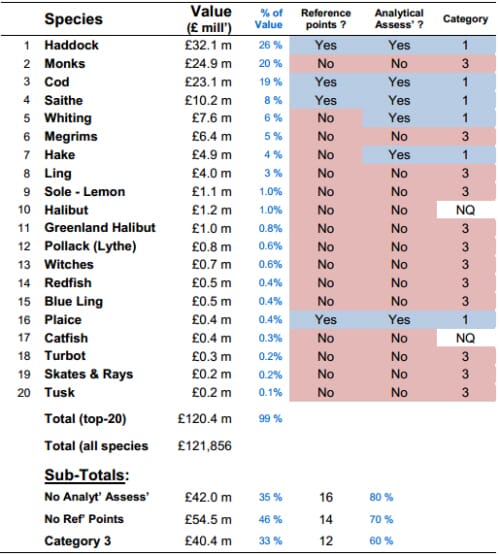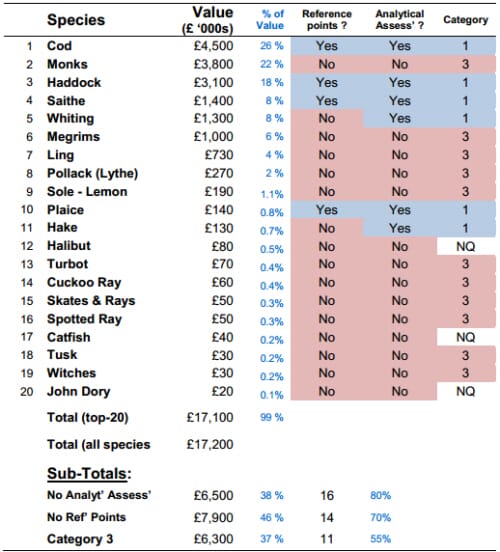Introduction
There is a general acceptance that fisheries management should be - indeed has to be - based on sound scientific information about the state of fish stocks. For European fisheries such advice has traditionally been provided by the International Council for the Exploration of the Sea (ICES), filtered through the European Commission’s Scientific, Technical and Economic Committee for Fisheries (STECF).
Despite this aspiration, the fact remains that scientific advice is not available or complete for all fish stocks. The European Commission has stated that scientific advice is missing for about two-thirds of stocks. The most common reason for the absence of scientific advice is a lack of necessary data.
The ‘problem’ of data deficient stocks has recently gained greater prominence because the Commission has attempted to adopt a policy of proposing automatic ‘precautionary’ cuts (of at least 25 per cent) in TACs and/or effort levels on stocks for which scientific advice is unavailable. (The situation is somewhat confused by the Commission’s references to ‘scientific advice on overfishing’, although the scientific advice normally covers a much broader range of issues, and stocks for which scientific advice is lacking are not necessarily overfished).
This analysis has been carried out to evaluate the extent of the problem of ‘data deficient’ stocks, including their number and value, for Shetland and Scottish demersal fishing vessels.
European Commission Categorisation of Stocks
In preparing its review of the 2011 scientific advice on fish stocks (which informed decisions on fishing opportunities for 2012) STECF was instructed by the European Commission to classify stocks into one of three categories. Category 3 was to include those stocks for which data are insufficient to carry out an analytical assessment, for which a 25 per cent reduction in TAC is specified.
Methodology
Data on the weight and value of landings by Shetland and Scottish fishing vessels were used to identify the most important demersal species (in terms of value). The data covered all landings (everywhere) by Shetland vessels and landings by Scottish vessels in Scottish ports in 2010. (Landings in Scottish ports were estimated to have accounted for about 86% of landings by Scottish vessels in 2010).
The main species landed by each fleet were ranked in order of importance by value. For each species the STECF Review of Scientific Advice for 2012 was consulted to determine:
- whether an analytical assessment was available for that species in the North Sea and/or West of Scotland areas;
- whether biological reference points had been defined (ditto.); and
- which category the species had been placed in.
The total values of landings of those species that: a) lacked analytical assessments; b) lacked biological reference points; and c) were classified in Category 3, were calculated.
Results
Landings by Scottish Vessels
Twenty species accounted for 99 per cent of the value of demersal fish landed by Scottish fishing vessels (in Scottish ports) in 2010 (Table 1).
Of these 20 species:
- No analytical assessments are available for 14 (70 per cent), landings of which were worth £42.0 million in 2010 (34 per cent of the total value of all demersal landings).
- No reference points are defined for 16 (80 per cent), landings of which were worth £54.5 million (45 per cent of the total).
- Twelve (60 per cent), landings of which were worth £40.4 million (33 per cent of the total), have been classified as Category 3 stocks.
The most important single ‘data deficient’ species for Scottish fishing vessels is monks (anglerfish), for which there is no analytical assessment, for which no reference points have been defined, and which has been classified as a Category 3 species. Landings of monks in Scotland by Scottish fishing vessels in 2010 were worth £24.9 million, 20 per cent of the value of all demersal landings.
Very few of the species that fall outside the top-20 have either analytical stock assessments or defined reference points. Of the top-40 demersal species landed by Scottish fishing vessels in 2010 (which accounted for 99.7 per cent of the total value of landings): 33 (80 per cent) lack an analytical assessment; 35 (85 per cent) lack reference points; and 28 (68 per cent) are classified in Category 3. (A further five species are non-quota species, which were thus not placed in any category, although the absence of assessments and reference points imply that they would be placed in Category 3.)
Landings by Shetland Vessels
Twenty species accounted for 99 per cent of the value of demersal fish landed by Shetland fishing vessels (everywhere) in 2010 (Table 2).
Of these 20 species:
- No analytical assessments are available for 14 (70 per cent), landings of which were worth £6.5 million in 2010 (38 per cent of the total value of demersal landings).
- No reference points are defined for 16 (80 per cent), landings of which were worth £7.9 million (46 per cent of the total).
- Eleven (55 per cent), landings of which were worth £6.3 million (37 per cent of the total), have been classified as Category 3 stocks.
As with the Scottish fleet, monks was the most important single ‘data deficient’ species landed by Shetland vessels, with landings worth £3.8 million in 2010, 22 per cent of the total value of all demersal landings.
Again, very few of the species that fall outside the top-20 have either analytical stock assessments or defined reference points. Of the 31 demersal species landed by Shetland fishing vessels in 2010, 23 (74 per cent) lack an analytical assessment; 25 (81 per cent) lack reference points; and 19 (61 per cent) are classified in Category 3. (A further four species are non-quota species, which again would presumably be placed in Category 3.)
Table 1: The top-20 demersal species (by value) landed by Scottish vessels in Scottish ports in 2010 and for each: the value of those landings; the value as a percentage of the total value of landings of all demersal species; whether there are reference points or an analytical assessment, and which category the species has been assigned to by STECF under European Commission criteria (‘NQ’ indicates non-quota species).
The numbers and total value of those species for which there are no analytical assessments, no reference points, and those in category 3, are also shown.

Table 2: The top-20 demersal species (by value) landed by Shetland vessels in 2010 (everywhere) and for each: the value of those landings; the value as a percentage of the total value of landings of all demersal species; whether there are reference points or an analytical assessment, and which category the species has been assigned to by STECF under European Commission criteria (‘NQ’ indicates non-quota species).
The numbers and total value of those species for which there are no analytical assessments, no reference points, and those in category 3, are also shown.

Conclusion
In spite of the aspiration of managing fish stocks on the basis of sound scientific advice, such advice is not available for the majority of demersal fish species caught by Scottish and Shetland fishing vessels. In terms of numbers, scientific advice is only available for half a dozen or so out of the 40 most important demersal species. In terms of value, ‘data deficient’ species account for almost half (~45 per cent) of the value of all demersal landings, some £50 million for Scottish vessels (£8 million for the Shetland fleet). Almost half of this is accounted for by a single species, monks (anglerfish).
To put these figures in context, Marine Scotland’s science budget for 2010-11 (which includes fisheries science, but also many other scientific activities) was £13.2 million. Given the value of ‘data deficient’ stocks to Scottish and Shetland fishing vessels, it is clear that any policy of reducing fishing opportunities for stocks that lack scientific advice is likely to have significant economic impacts, especially if they were to be repeated year-on-year. An across-the-board 25 per cent cut in quotas for ‘data deficient’ stocks, as was proposed, could cost the Scottish fleet some £12.5 million (all else being equal).


